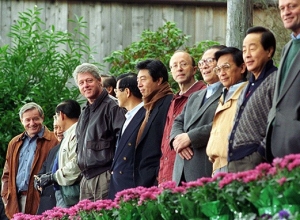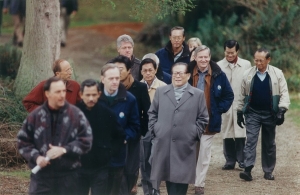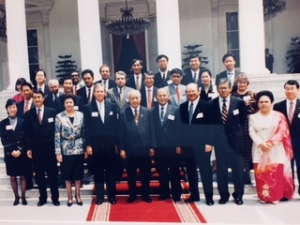2019 marks the 25th anniversary of the National Center for APEC. To celebrate this milestone, NCAPEC is publishing a series of articles that will look back at the private sector’s contributions to APEC and look forward the potential for further collaboration over NCAPEC’s next 25 years.
In November 1993, President Bill Clinton seized a unique opportunity to take a fledging gathering of government ministers from around the Asia Pacific and turn it into the region’s premier gathering of political leaders. The heads of 15 economies, including President Clinton, gathered in a Native American long house located on Blake Island, a state park situated just off the coast of Seattle, Washington. At the time, this meeting was the biggest gathering of Asian and Pacific leaders since President Lyndon Johnson convened a summit meeting in 1966 in Manila to enlist support for the Vietnam War.

APEC Leaders assembled together for the first time.
Speaking in 2014 about that first APEC Leaders’ meeting, President Clinton stated, “It was an important meeting at a pivotal time. We were entering a new era of globalization and the Asia-Pacific region was well on its way to becoming the most important source of global growth and dynamism.” President Clinton went on to state that, “In order to seize the opportunity, we had to find ways to work together to advance our shared interests and overcome some common challenges. This meeting has helped to do just that.”

APEC leaders walking through Blake Island, WA, together.
The impact of the 1993 meeting is still felt some 25 years later. First, the gathering set the stage for the 1994 establishment of the Bogor Goals for free and open trade and investment in the region by 2010 (for developed economies)/2020 (for developing economies). As APEC’s membership grew to 21 economies in subsequent years, the Bogor Goals guided APEC’s work while building a community and cooperative spirit to tackle the economic and social challenges of development.
Additionally, in Seattle APEC Leaders received recommendations from the newly-created Pacific Business Forum (PBF) – chaired by the United States’ PBF representative, Fluor Corporation’s Les McGraw – highlighting the importance of collaborating with the private sector to promote growth and prosperity in the region. The PBF also called for APEC to establish a permanent mechanism for business advice to Leaders, an APEC Business Advisory Council. APEC established the APEC Business Advisory Council in 1995.

Presentation of the first PBF report to then President Suharto at the Istana in Jakarta.
Following the Seattle APEC meetings, U.S. companies that had come together to support the 1993 Leaders’ Meeting took the prescient step of establishing the National Center for APEC, an organization that would serve as the voice of U.S. business in APEC by seeking expanded engagement for the U.S. private sector in APEC’s official meetings, and eventually through its role as the U.S. Secretariat for the APEC Business Advisory Council.
The 1993 APEC Leaders’ meeting on Blake Island set the foundations for both APEC and NCAPEC. It is fitting that during its 25th anniversary year, NCAPEC will host the first ABAC meeting of 2019, a gathering that embodies the important role that the private sector continues to play APEC. This time the meeting will be in Atlanta, Georgia, and the spirit of cooperation shown by APEC Leaders in 1993 will surely be carried on!






